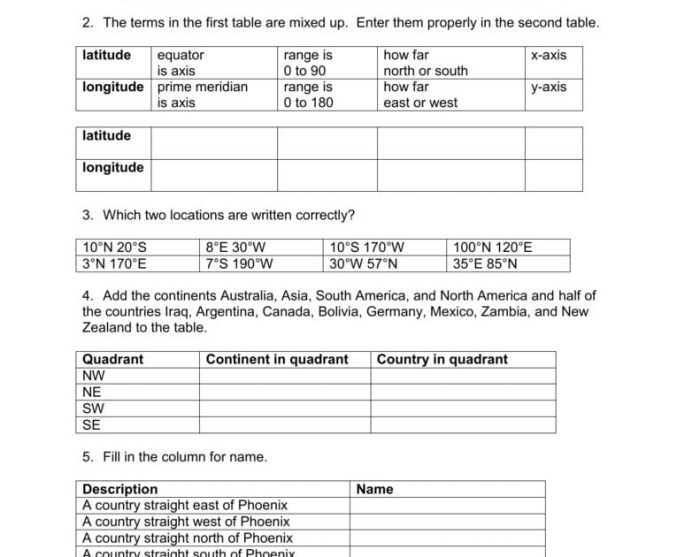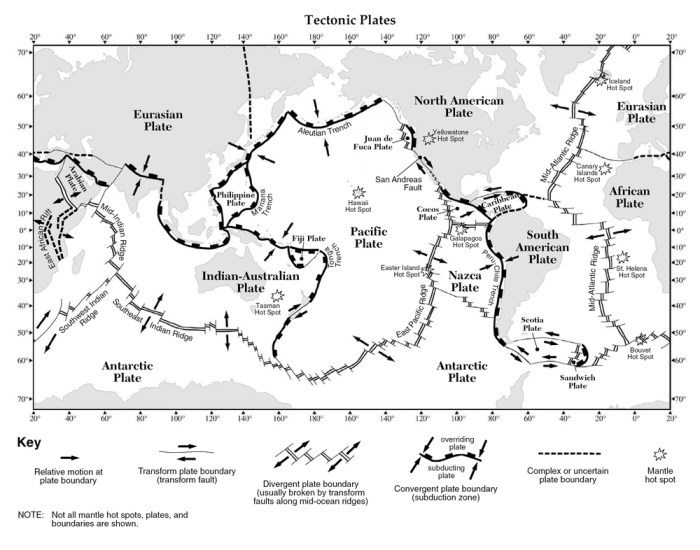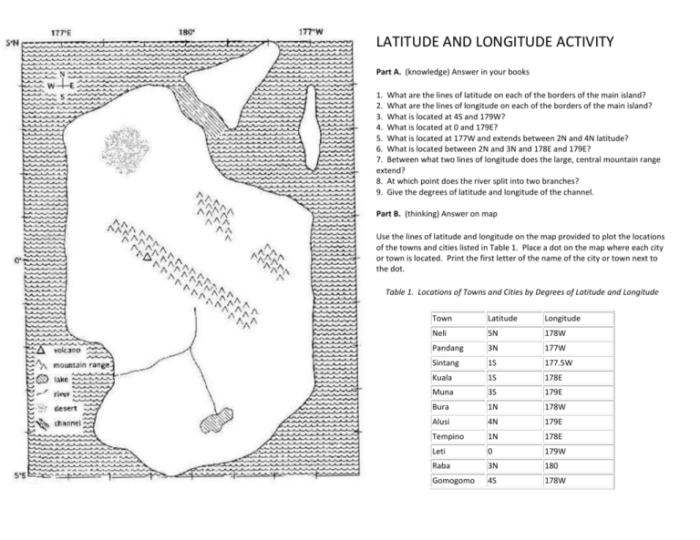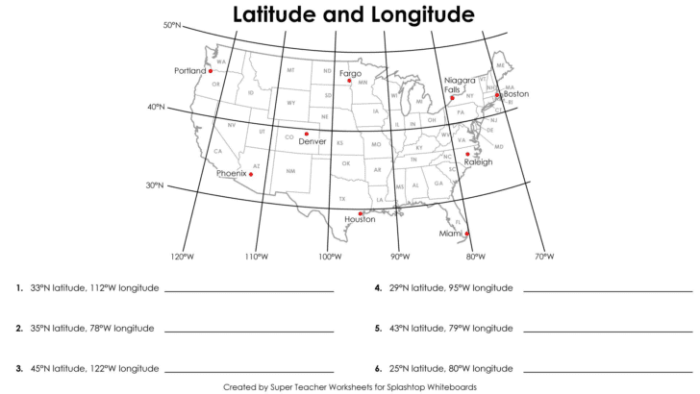Latitude and longitude on the ESRT answer key play a crucial role in locating points on Earth, providing a systematic framework for navigation, mapping, and scientific research. This guide delves into the intricacies of latitude and longitude, their representation, and their practical applications, empowering readers with a comprehensive understanding of these fundamental geographic concepts.
From defining parallels and meridians to explaining the standard format for expressing coordinates, this guide unravels the complexities of latitude and longitude. It also provides practical tips on locating these lines on a map and discusses the factors that affect their accuracy and precision.
Overview of Latitude and Longitude
Latitude and longitude are geographic coordinates that help us locate points on Earth’s surface. Latitude refers to the distance north or south of the Equator, while longitude measures the distance east or west of the Prime Meridian. These coordinates are expressed as angles, with latitude ranging from 0° at the Equator to 90° at the poles, and longitude ranging from 0° at the Prime Meridian to 180° at the opposite meridian.
Latitude is measured using parallels, imaginary lines running parallel to the Equator. The most important parallel is the Equator, which is located at 0° latitude. Other parallels include the Tropic of Cancer (23.5° N), the Tropic of Capricorn (23.5° S), the Arctic Circle (66.5° N), and the Antarctic Circle (66.5° S).
Longitude is measured using meridians, imaginary lines running from the North Pole to the South Pole. The most important meridian is the Prime Meridian, which passes through Greenwich, England, and is located at 0° longitude. Other meridians include the 180th meridian, which is also known as the International Date Line.
Representation of Latitude and Longitude

Latitude and longitude coordinates are typically expressed in degrees, minutes, and seconds. Degrees are the largest unit, followed by minutes, and then seconds. For example, the coordinates of the Statue of Liberty are 40°42’58.6″ N, 74°02’40.1″ W.
This means that the Statue of Liberty is located 40 degrees, 42 minutes, and 58.6 seconds north of the Equator, and 74 degrees, 2 minutes, and 40.1 seconds west of the Prime Meridian.
Latitude is indicated by the letters N (north) or S (south), while longitude is indicated by the letters E (east) or W (west). For example, the coordinates of the Eiffel Tower are 48°51’29.6″ N, 2°17’40.2″ E. This means that the Eiffel Tower is located 48 degrees, 51 minutes, and 29.6 seconds north of the Equator, and 2 degrees, 17 minutes, and 40.2 seconds east of the Prime Meridian.
Finding Latitude and Longitude on a Map

Latitude and longitude lines are typically shown on maps as a grid. The horizontal lines represent latitude, while the vertical lines represent longitude. The intersection of a latitude line and a longitude line gives the coordinates of a point on the map.
To find the latitude and longitude of a point on a map, first locate the point on the grid. Then, find the nearest latitude line and longitude line to the point. The latitude of the point is the latitude of the nearest latitude line, and the longitude of the point is the longitude of the nearest longitude line.
For example, if a point is located halfway between the 40° N and 41° N latitude lines, and halfway between the 74° W and 75° W longitude lines, then the coordinates of the point are 40°30′ N, 74°30′ W.
Applications of Latitude and Longitude

Latitude and longitude are used in a wide variety of applications, including navigation, mapping, and scientific research.
- Navigation:Latitude and longitude are used to navigate ships, airplanes, and other vehicles. GPS (Global Positioning System) devices use latitude and longitude coordinates to determine the location of a vehicle.
- Mapping:Latitude and longitude are used to create maps. Maps show the location of countries, cities, and other features on Earth’s surface.
- Scientific research:Latitude and longitude are used in scientific research to study the Earth’s climate, geology, and other aspects of the planet.
Accuracy and Precision of Latitude and Longitude

The accuracy and precision of latitude and longitude measurements depend on the technology used to make the measurements.
- Accuracy:Accuracy refers to how close a measurement is to the true value. GPS devices can typically measure latitude and longitude with an accuracy of within a few meters.
- Precision:Precision refers to how consistent a measurement is. GPS devices can typically measure latitude and longitude with a precision of within a few centimeters.
The accuracy and precision of latitude and longitude measurements can be improved by using different technologies, such as differential GPS (DGPS) and real-time kinematic (RTK) GPS.
Latitude and Longitude in Real-World Scenarios
Latitude and longitude are used in a variety of real-world scenarios, including weather forecasting, disaster management, and navigation apps.
- Weather forecasting:Latitude and longitude are used to track the movement of weather systems. This information is used to create weather forecasts.
- Disaster management:Latitude and longitude are used to locate people and resources in the event of a disaster. This information is used to coordinate relief efforts.
- Navigation apps:Latitude and longitude are used by navigation apps to help people find their way. These apps use GPS technology to determine the user’s location and then provide directions to the desired destination.
FAQ Resource: Latitude And Longitude On The Esrt Answer Key
What is the standard format for expressing latitude and longitude coordinates?
Latitude and longitude coordinates are typically expressed in degrees, minutes, and seconds, followed by the appropriate hemisphere indicator (N/S for latitude and E/W for longitude).
How can I locate latitude and longitude lines on a map?
Latitude lines run parallel to the equator, while longitude lines run perpendicular to the equator. Graticules and scales on maps help identify and measure these lines.
What are some practical applications of latitude and longitude?
Latitude and longitude are used in navigation, mapping, surveying, weather forecasting, disaster management, and scientific research.